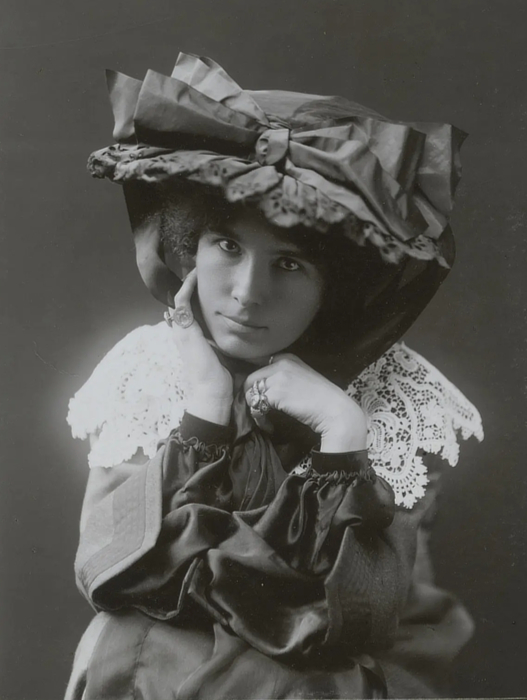MARGUERITE BURNAT-PROVINS
b. 1872 Arras, France
d. 1952 Grasse, France
WORKS | BIOGRAPHY | EXHIBITIONS | PUBLICTIONS
WORKS
BIOGRAPHY
 Marguerite Burnat-Provins was the eldest of seven children from a wealthy, educated family. Encouraged by her father, she started writing and painting from a young age. In 1891, she travelled to Paris to study art at private institutions. She married Swiss architect Adolphe Burnat at the age of twenty-four. The couple settled in Vevey, Adolphe's hometown. In 1898, she discovered the Valais region through her friend, the artist Ernst Biéler, and joined the artists of the 'Savièse School'. Burnat-Provins painted, embroidered, designed posters and began writing and illustrating her own books.
Marguerite Burnat-Provins was the eldest of seven children from a wealthy, educated family. Encouraged by her father, she started writing and painting from a young age. In 1891, she travelled to Paris to study art at private institutions. She married Swiss architect Adolphe Burnat at the age of twenty-four. The couple settled in Vevey, Adolphe's hometown. In 1898, she discovered the Valais region through her friend, the artist Ernst Biéler, and joined the artists of the 'Savièse School'. Burnat-Provins painted, embroidered, designed posters and began writing and illustrating her own books.
In 1906, she began a passionate affair with Paul de Kalbermatten, an engineer. He inspired her to write the book Le livre pour toi (1907). The book's great success opened the doors of Paris to her. In 1908, she divorced her husband to marry Paul. The couple then moved to Bayonne.
In the summer of 1914, the hypersensitive woman began to suffer from hallucinations. Strange names constantly flooded her mind and forced her to write them down. Soon she began to draw the distinctive characters associated with these names, which appeared to her in visions. Burnat-Provins referred to these as the people of her imaginary city, Ma Ville. Announced by a muffled voice, figures would often appear to her at dusk, accompanied by their names and character traits. Burnat-Provins felt an irresistible compulsion to draw the apparitions, and so embarked on a unique and magnificent creative project. Personifications of allegories and symbols mingle among the inhabitants of Ma Ville. Burnat-Provins often captured the personality, temperament and condition of the figures with just a few strokes. The accompanying text emphasizes and reveals the subject's disposition.
Along with the visionary guests came paranormal phenomena, which also found their way into Burnat-Provins' life. Sometimes, objects would disappear around her and be found again in faraway places. The most striking example was a music book that vanished in Le Conquet and reappeared in Paris.
From 1914 until the end of her life, Burnat-Provins devoted herself almost exclusively to drawing these visionary visitors. Her complete body of work comprises around three thousand drawings and watercolors of figures that are sometimes half anthropomorphic and half zoomorphic, all of which have strong symbolic connotations.
SELECTED EXHBITIONS
2021 Musée des Beaux-Arts, Arras 05/19 – 08/15/2021
2020 Musée Jenisch Vevey 10/30/2020 – 4/11/2021
2019 Flying High: Women Artists of Art Brut. Bank Austria Kunstforum, Vienna, Austria, 2/15/2019 – 6/23/2019
2019 Theatre, 4th Biennale of Art Brut, Collection de l'Art Brut, Lausanne, 11/29/2019 – 08/30/2020
2003 Marguerite Burnat-Provins: de l'Art nouveau à l'art hallucinatoire. Fondation Neumann, Gingins and Collecion de l'Art Brut, Lausanne 05/22 – 09/14/2003
1932 Les secrets de l'inspiration, Gallery of the Museum of Art, Geneva, Switzerland 5/28/1932 – 6/19/1932
1932 Les secrets de l'inspiration, Jean Charpentier Gallery, Paris, France 3/3/1932 – 4/13/1932
PUBLICATIONS
Duroux, Xavier, Les créations polymorphes d’une artiste étonnante. In: Le Nouvelliste, 29. Oktober 2020.
Dubuis, Catherine, Les forges du paradis, Histoire d’une vie: Marguerite Burnat-Provins. Vevez: Éditions de l’Aire, 1999.
Murray-Robertson, Anne (ed.), Marguerite Burnat-Provins. Cœur sauvage. Gollion: Infolio, 2019.
Murray-Robertson, Anne, Marguerite Burnat-Provins. Oser la liberté. Gollion: Infolio, collection Presto, 2020.
Wyder, Bernard, Marguerite Burnat-Provins. Exhibition catalogue. Martigny: Le Manoir, 1980.

